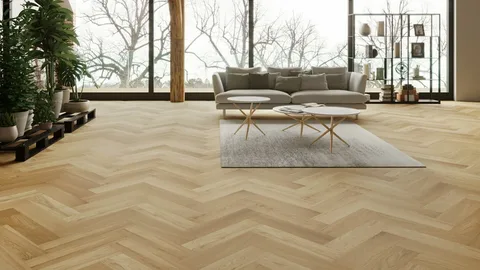
In today’s world, sustainability has become a paramount concern across various industries, including flooring. As homeowners and designers seek environmentally friendly options, sustainable practices in parquet flooring have gained prominence. Parquet flooring, known for its timeless elegance and durability, can also be produced and installed in a sustainable manner, minimizing environmental impact while maximizing aesthetic appeal. In this discussion, we will explore the key sustainable practices in parquet flooring and their benefits for both the environment and homeowners.
Sourcing Responsible Materials
Sustainable parquet flooring Dubai begins with responsible sourcing of materials. This involves selecting wood from well-managed forests or reclaimed sources. Opting for FSC (Forest Stewardship Council) certified wood ensures that the timber used in parquet flooring comes from forests managed in an environmentally and socially responsible manner, promoting biodiversity and forest regeneration.
Utilizing Reclaimed Wood by parquet flooring
Reclaimed wood offers a sustainable alternative to newly harvested timber for parquet flooring. Reclaimed wood is sourced from old structures such as barns, warehouses, or factories, repurposing timber that would otherwise go to waste. By using reclaimed wood in parquet flooring, manufacturers help reduce deforestation and minimize the environmental impact associated with logging and timber extraction.
Choosing Eco-Friendly Adhesives
Adhesives play a crucial role in the installation of parquet flooring. Sustainable practices involve selecting eco-friendly adhesives that have low VOC (volatile organic compound) emissions. Low VOC adhesives minimize indoor air pollution and contribute to healthier indoor environments for occupants. Water-based adhesives, in particular, are a sustainable choice as they have lower environmental impact compared to solvent-based alternatives. See this: https://www.youtube.com/shorts/_dEUEj06ht4
Opting for Non-Toxic Finishes
Finishes applied to parquet flooring not only enhance its aesthetic appeal but also protect the wood from wear and tear. Sustainable practices emphasize the use of non-toxic finishes such as natural oils or water-based polyurethanes. These finishes emit fewer harmful chemicals into the air, reducing indoor air pollution and promoting better indoor air quality. Non-toxic finishes also contribute to a healthier living environment for homeowners and their families.
Implementing Efficient Manufacturing Processes
Sustainable parquet flooring manufacturers prioritize energy efficiency and waste reduction in their production processes. By implementing efficient manufacturing techniques and utilizing renewable energy sources, manufacturers can minimize energy consumption and greenhouse gas emissions associated with production. Additionally, reducing waste through proper recycling and resource optimization further reduces the environmental footprint of parquet flooring production.
Promoting Longevity and Durability
One of the most sustainable practices in parquet flooring is designing and constructing floors that are built to last. High-quality parquet flooring, when properly installed and maintained, can withstand the test of time, reducing the need for frequent replacements and minimizing waste. By choosing durable materials and employing skilled craftsmanship, homeowners can enjoy long-lasting and sustainable flooring solutions that require minimal upkeep. Read more: https://toastul.com/
Supporting Local and Artisanal Production
Supporting local and artisanal production of parquet flooring contributes to sustainable practices by reducing transportation emissions and supporting local economies. Choosing locally sourced materials and working with skilled artisans and craftsmen not only reduces the carbon footprint of flooring production but also fosters community resilience and economic stability.
Investing in Responsible Disposal and Recycling
At the end of its lifespan, sustainable parquet flooring can be responsibly disposed of or recycled. Wood flooring can be repurposed for various applications, including furniture, cabinetry, or architectural elements, extending its lifecycle and reducing waste. By investing in responsible disposal and recycling practices, homeowners and manufacturers can minimize the environmental impact of flooring materials and contribute to circular economy principles.
Conclusion
In conclusion, sustainable practices in them can encompass a range of strategies aimed at reducing environmental impact, promoting resource conservation, and fostering healthier indoor environments. From responsible material sourcing and reclaimed wood utilization to eco-friendly adhesives and non-toxic finishes, every aspect of parquet flooring production and installation can be aligned with sustainability principles. By prioritizing longevity, durability, and environmental stewardship, sustainable parquet flooring offers homeowners an environmentally conscious and aesthetically pleasing flooring option that stands the test of time. As awareness of environmental issues continues to grow, the demand for sustainable flooring solutions like parquet flooring is expected to rise, driving innovation and advancement in sustainable practices across the industry.
FAQS
Why is sustainable parquet flooring important?
It is important because it promotes responsible resource management, reduces environmental impact, and contributes to healthier indoor environments. By sourcing materials responsibly, using eco-friendly adhesives and finishes, and prioritizing longevity and durability, it helps to minimize deforestation, indoor air pollution, and waste generation. It also aligns with increasing consumer demand for environmentally friendly products and supports the transition towards more sustainable practices in the construction and design industries.
What are the benefits of choosing reclaimed wood for parquet flooring?
Choosing reclaimed wood for them can provide several benefits. Firstly, it reduces the demand for newly harvested timber, thereby helping to preserve forests and biodiversity. Secondly, reclaimed wood repurposes materials that would otherwise go to waste, minimizing landfill contributions and promoting resource conservation. Additionally, reclaimed wood often carries unique character and history, adding charm and authenticity to their installations. Overall, opting for reclaimed wood aligns with sustainability principles and contributes to the creation of eco-friendly and aesthetically pleasing interiors.



